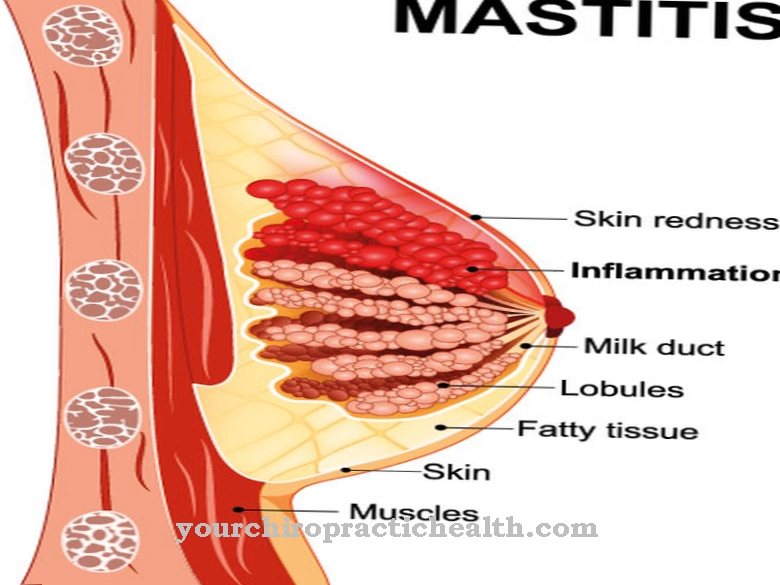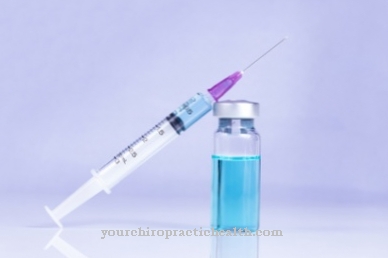In the Trisomy 8 it is a genome mutation that results in a chromosome aberration. The symptoms depend on the type of mutation. Many patients with trisomy eight show a mild course with relatively normal intelligence.
What is trisomy 8?
The Trisomy 8 is a rare chromosome peculiarity that goes back to a genome mutation and occurs sporadically. The disease is also known as Warkany Syndrome 2 and this name goes back to the pediatrician Joseph Warkany, who first described the symptom complex in the 20th century. Only around 120 cases of trisomy 8 have been documented since it was first described.
The trisomy of chromosome eight is predominantly in the form of a mosaic mutation and affects both boys and girls. Some of the symptoms are already pronounced before birth and show up on prenatal ultrasound. A trisomy is always used when there are three copies of the genes instead of two gene copies.
The symptoms of trisomy eight depend on the one hand on the affected section of the chromosome and on the other hand on the completeness of the trisomy and thus the respective subspecies of the causative mutation. Severe trisomies are often associated with abortion. The affected fetus cannot survive a severe form of trisomy.
causes
As with any other trisomy, the primary cause of trisomy eight is a genome mutation. This is to be distinguished from gene mutations that do not change the number of chromosomes within the individual body cells. Gene mutations change the structure of DNA because the sequence of the building blocks is changed. In the case of genome mutation, on the other hand, the genetic material itself is changed and has an abnormal set of chromosomes.
A whole set of chromosomes can be missing in the individual cells, incorrectly arranged or in duplicate. The genome mutation results from faulty cell division during the first or second meiosis in the context of meiosis. This type of mutation can correspond to a partial mutation and in this case does not affect the entire genome.
The mutation can also correspond to a translocation and then results in the adhesion of an additional chromosome set to one of the other chromosome sets. If, on the other hand, there is a mosaic mutation in the genome, two sister chromatids have not separated during mitosis and the trisomy is limited to certain cells in the body, while other cells have a normal set of chromosomes.
Symptoms, ailments & signs
Many symptoms of trisomy 8 can be seen before birth. In addition to a heart defect and malformation of the kidneys, these symptoms include, for example, enlargement of the renal pelvis, tetramellia and scoliosis, lordosis or kyphosis. Block vertebrae, clinodactyly and camptodactylia can also be identified prenatally.
The same applies to the characteristic mandibular retrognathia, brachydactyly or hypoplasia of the kneecap. The clinical picture is extremely variable, especially after birth, and depends primarily on the shape of the trisomy. Generalizations are almost impossible.
Common symptoms are arthrogryposis, a so-called spina bifida occulta, and abnormal plantar furrows or a sandal furrow, palmar furrow, and four-finger furrow. Often those affected have ears that are set deep and that are large or long. Their anthelix is often underdeveloped. In many cases the forehead is high. In addition to a short neck, there may be narrow sloping shoulders. The rib cage is often exceptionally long.
The number and strength of the ribs are abnormal. These symptoms can be associated with accessory nipples, a Gothic palate or a cleft palate. Exceptionally full lips and an everted lower lip are just as much a part of the clinical picture as hypotelorism, ptosis or a squint. In most cases there is also a slight to moderate impairment of cognitive abilities. Despite this long list of symptoms, there are trisomy patients who are almost asymptomatic for life.
Diagnosis & course of disease
The diagnosis of trisomy 8 can be made prenatal. The fine ultrasound gives the first clues. However, a prenatally reliable diagnosis can only be made by analyzing the chromosomes. An amniocentesis or a chorionic villus sampling can be performed prenatally. However, a mosaic trisomy 8 can also be subject to local restrictions.
All prenatal diagnostics of trisomy are considered to be uncertain and often produce false positive results. Postnatally, the diagnosis can be suspected depending on the clinical picture. Genetic analysis confirms or rules out the suspected diagnosis. The prognosis depends on the proportion of trisomeric and disomeric cells. Mental and physical development often correlate in the course of the disease. A normal development is possible with a mild trisomy 8.
When should you go to the doctor?
Medical treatment is definitely necessary for trisomy 8. The affected person depends on early detection of the disease so that further complications and complaints can be prevented.The earlier trisomy 8 is detected, the better the further course of this disease will usually be. A doctor should then be contacted if the person concerned suffers from a heart defect. This should always be checked through regular examinations.
Furthermore, limitations in intelligence can also indicate the disease and should be checked by a doctor. Some patients also suffer from strabismus or other visual problems and can therefore not easily take part in everyday life. Mental moods or even depression can also indicate this disease.
For trisomy 8, a general practitioner or a pediatrician should be consulted. For further treatment, however, a visit to a specialist is necessary in order to properly treat the symptoms.
Treatment & Therapy
Trisomy 8 is still one of the incurable diseases today. A causal therapy is generally not available for patients with trisomy, since any gene therapies have not yet been approved for treatment. Ultimately, incurable diseases can only be alleviated through symptomatic therapy. This symptomatic therapy depends on the symptoms present in the individual case.
The therapy focuses primarily on deformities and functional impairments of the vital organs. In trisomy 8, therefore, the heart defect is initially given the greatest attention. Surgical intervention can sometimes correct existing heart defects. Agnosia of the kneecap can be corrected by reconstructive surgery to restore normal mobility.
Fluid accumulations in the neck area can be drained and kidney formities with functional impairment of the kidneys are treated with dialysis and later, if necessary, a transplant. The malformations of the face and fingers or toes can also be resolved surgically. However, this approach is not absolutely necessary and does not have to take place immediately after the birth.
It is more important to have early intervention with the aim of a mentally normal development. In mild forms of trisomy eight, intelligence is usually not noticeably impaired and the patients may not have to undergo any surgical treatment steps.
prevention
Preventive measures are not available for trisomy 8. However, after a prenatal diagnosis, parents can decide against the child.
Aftercare
Follow-up care for trisomy 8 is varied. This is due to the fact that the symptoms of the patients differ significantly. While some of the affected children have severe intellectual disabilities and require appropriate care throughout their lives, other patients are only slightly mentally impaired or even completely normal.
However, almost all children with trisomy 8 benefit from early intervention with occupational therapy and other measures. Follow-up care does not only include the treatment of the actual patient. The relatives should also be closely involved. Parents sometimes need help from domestic help or a nursing service, as caring for their own child can be very stressful.
Psychological support may also be appropriate in some cases. If the parents of a child with trisomy 8 wish to have another child, they are often concerned that the defect could recur. Therefore, comprehensive follow-up care also includes advice for parents from a human geneticist.
Although the risk of recurrence is usually low, existing fears should be taken seriously. If pregnancy occurs again, a chorionic villus sampling or amniocentesis can clarify whether there is a chromosomal disorder. However, such an intervention poses an increased risk of miscarriage and should therefore be carefully considered.
You can do that yourself
People with trisomy 8 need permanent support in everyday life. It is the task of relatives and friends to support the person concerned in everyday life and to help him with everyday tasks. This includes not only aspects such as personal hygiene or getting around, but also emotional support.
Because trisomy 8 is associated with severe mental illness, depending on its severity, discussions with therapists and self-help groups may need to be held. The reduced intelligence can be partially compensated by cognitive training. Brain jogging, autogenic training and a number of other measures that promote intelligence and promote healthy behavior are effective. In the case of external malpositions, surgical measures must be taken. It is important to initiate this at an early stage so that physical development can proceed as normal as possible. The parents of affected children should contact the responsible specialist.
People with trisomy 8 usually require professional care in a facility. The psychological complaints need to be treated with medication as well as with talk therapy, distraction and a number of other measures. The Association for Trisomy Patients gives those affected and their relatives further information about the disease and contact points for further advice.


.jpg)
.jpg)
.jpg)
.jpg)











.jpg)







.jpg)


